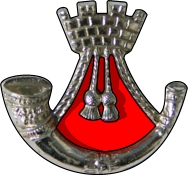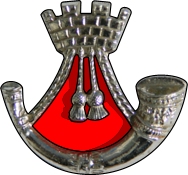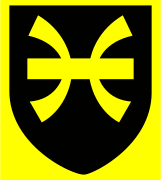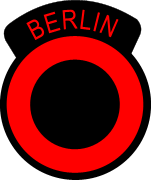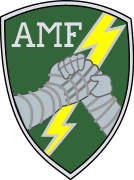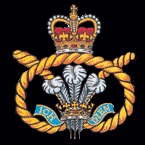
The Staffordshire Regiment (Prince of Wales') (or simply "Staffords" for short) was an infantry regiment of the British Army, part of the Prince of Wales' Division. The regiment was formed in 1959 by the amalgamation of the South Staffordshire Regiment and the North Staffordshire Regiment (Prince of Wales'), and in 2007 was amalgamated with the Cheshire Regiment and the Worcestershire and Sherwood Foresters Regiment to become the 3rd Battalion, Mercian Regiment.

The King's Own Scottish Borderers (KOSBs) was a line infantry regiment of the British Army, part of the Scottish Division. On 28 March 2006 the regiment was amalgamated with the Royal Scots, the Royal Highland Fusiliers, the Black Watch, the Highlanders, the Argyll and Sutherland Highlanders, 52nd Lowland Regiment, and 51st Highland Regiment to form the Royal Regiment of Scotland. However, after just a few months the battalion merged with the Royal Scots Battalion to form the Royal Scots Borderers.

The Royal Highland Fusiliers, 2nd Battalion, The Royal Regiment of Scotland is an infantry battalion of the Royal Regiment of Scotland.

The Argyll and Sutherland Highlanders (Princess Louise's) was a line infantry regiment of the British Army that existed from 1881 until amalgamation into the Royal Regiment of Scotland on 28 March 2006.

The Prince of Wales's Own Regiment of Yorkshire was an infantry regiment of the British Army, part of the King's Division. It was created in 1958 by the amalgamation of the West Yorkshire Regiment and the East Yorkshire Regiment. After 48 years service, the regiment was amalgamated again, this time with two other Yorkshire regiments. It became the 1st Battalion of the Yorkshire Regiment, with the Green Howards forming the 2nd Battalion and the Duke of Wellington's Regiment forming the 3rd Battalion on 6 June 2006. Following further merges, in 2012, the battalion was redesignated as the new 2nd Battalion (2Yorks).

The Somerset Light Infantry (Prince Albert's) was a light infantry regiment of the British Army, which served under various titles from 1685 to 1959. In 1959, the regiment was amalgamated with the Duke of Cornwall's Light Infantry to form the Somerset and Cornwall Light Infantry which was again amalgamated, in 1968, with the King's Own Yorkshire Light Infantry, the King's Shropshire Light Infantry and the Durham Light Infantry to form The Light Infantry. In 2007, however, The Light Infantry was amalgamated further with the Devonshire and Dorset Regiment, the Royal Gloucestershire, Berkshire and Wiltshire Regiment and the Royal Green Jackets to form The Rifles.
The Devonshire and Dorset Regiment, usually just known as the Devon and Dorsets, was an infantry regiment of the British Army formed in 1958 by the amalgamation of two county regiments, the Devonshire Regiment and the Dorset Regiment. In 2007 it was itself merged into The Rifles, a "large regiment". Members of the regiments referred to themselves as being a Janner.

The Green Howards , frequently known as the Yorkshire Regiment until the 1920s, was a line infantry regiment of the British Army, in the King's Division. Raised in 1688, it served under various titles until it was amalgamated with the Prince of Wales's Own Regiment of Yorkshire and the Duke of Wellington's Regiment, all Yorkshire-based regiments in the King's Division, to form the Yorkshire Regiment on 6 June 2006.

The Cameronians (Scottish Rifles) was a rifle regiment of the British Army, the only regiment of rifles amongst the Scottish regiments of infantry. It was formed in 1881 under the Childers Reforms by the amalgamation of the 26th Cameronian Regiment and the 90th Perthshire Light Infantry. In 1968, when reductions were required, the regiment chose to be disbanded rather than amalgamated with another regiment, one of only two infantry regiments in the British Army to do so, with the other being the York and Lancaster Regiment. It can trace its roots to that of the Cameronians, later the 26th of Foot, who were raised in 1689. The 1881 amalgamation coincided with the Cameronian's selection to become the new Scottish Rifles.

The 13th/18th Royal Hussars was a cavalry regiment of the British Army. It was formed by the amalgamation of the 13th Hussars and the 18th Royal Hussars in 1922 and, after service in the Second World War, it amalgamated with the 15th/19th The King's Royal Hussars to form the Light Dragoons in 1992.

The King's Shropshire Light Infantry (KSLI) was a light infantry regiment of the British Army, formed in the Childers Reforms of 1881, but with antecedents dating back to 1755. It served in the Second Boer War, World War I and World War II. In 1968, the four regiments of the Light Infantry Brigade amalgamated to form The Light Infantry, with the 1st KSLI being redesignated as the 3rd Battalion of the new regiment.

The King's Own Yorkshire Light Infantry (KOYLI) was a light infantry regiment of the British Army. It officially existed from 1881 to 1968, but its predecessors go back to 1755. In 1968, the regiment was amalgamated with the Somerset and Cornwall Light Infantry, the King's Shropshire Light Infantry and the Durham Light Infantry to form The Light Infantry, which in turn was merged with the Devonshire and Dorset Regiment, the Royal Gloucestershire, Berkshire and Wiltshire Regiment and the Royal Green Jackets to become The Rifles in 2007.
The 16th/5th The Queen's Royal Lancers was a cavalry regiment of the British Army. It was formed by the amalgamation of the 16th The Queen's Lancers and the 5th Royal Irish Lancers in 1922. The reason for the uniquely atypical regimental title was that the 5th had been re-raised in 1858 almost 60 years after being disbanded, and when re-raised took precedence after the 17th Lancers. After service in the Second World War and the Gulf War, the regiment amalgamated with the 17th/21st Lancers to form the Queen's Royal Lancers in 1993.

The Devonshire Regiment was a line infantry regiment of the British Army that served under various titles and served in many wars and conflicts from 1685 to 1958, such as the Second Boer War, the First World War and the Second World War. In 1958 the regiment was amalgamated with the Dorset Regiment to form the Devonshire and Dorset Regiment which, in 2007, was amalgamated with the Royal Gloucestershire, Berkshire and Wiltshire Regiment, the Royal Green Jackets and The Light Infantry to form a new large regiment, The Rifles.

The East Surrey Regiment was a line infantry regiment of the British Army in existence from 1881 until 1959. The regiment was formed in 1881 under the Childers Reforms by the amalgamation of the 31st (Huntingdonshire) Regiment of Foot, the 70th (Surrey) Regiment of Foot, the 1st Royal Surrey Militia and the 3rd Royal Surrey Militia.
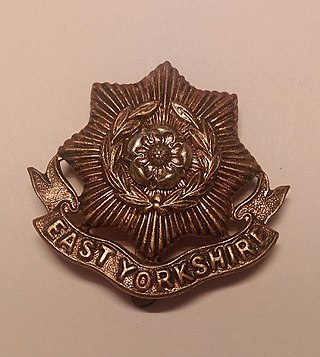
The East Yorkshire Regiment was a line infantry regiment of the British Army, first raised in 1685 as Sir William Clifton's Regiment of Foot and later renamed the 15th Regiment of Foot. It saw service for three centuries, before eventually being amalgamated with the West Yorkshire Regiment in 1958, to form the Prince of Wales's Own Regiment of Yorkshire. Subsequently, the regiment amalgamated with the Green Howards and the Duke of Wellington's Regiment to form the Yorkshire Regiment on 6 June 2006.

The Suffolk Regiment was an infantry regiment of the line in the British Army with a history dating back to 1685. It saw service for three centuries, participating in many wars and conflicts, including the First and Second World Wars, before being amalgamated with the Royal Norfolk Regiment to form the 1st East Anglian Regiment in 1959 which, in 1964, was further amalgamated with the 2nd East Anglian Regiment, the 3rd East Anglian Regiment and the Royal Leicestershire Regiment to create the present Royal Anglian Regiment.

The King's Own Royal Regiment (Lancaster) was a line infantry regiment of the British Army. It served under various titles and fought in many wars and conflicts, including both the First and the Second World Wars, from 1680 to 1959. In 1959, the regiment was amalgamated with the Border Regiment to form the King's Own Royal Border Regiment.

The Duke of Cornwall's Light Infantry (DCLI) was a light infantry regiment of the British Army in existence from 1881 to 1959.

The 10th Baluch or Baluch Regiment was a regiment of the British Indian Army from 1922 to 1947. After independence, it was transferred to the Pakistan Army. In 1956, it was amalgamated with the 8th Punjab and Bahawalpur Regiments. During more than a hundred years of military service, the 10th Baluch Regiment acquired a distinguished record amongst the regiments of the British Indian Army. Its list of honours and awards includes four Victoria Crosses.

